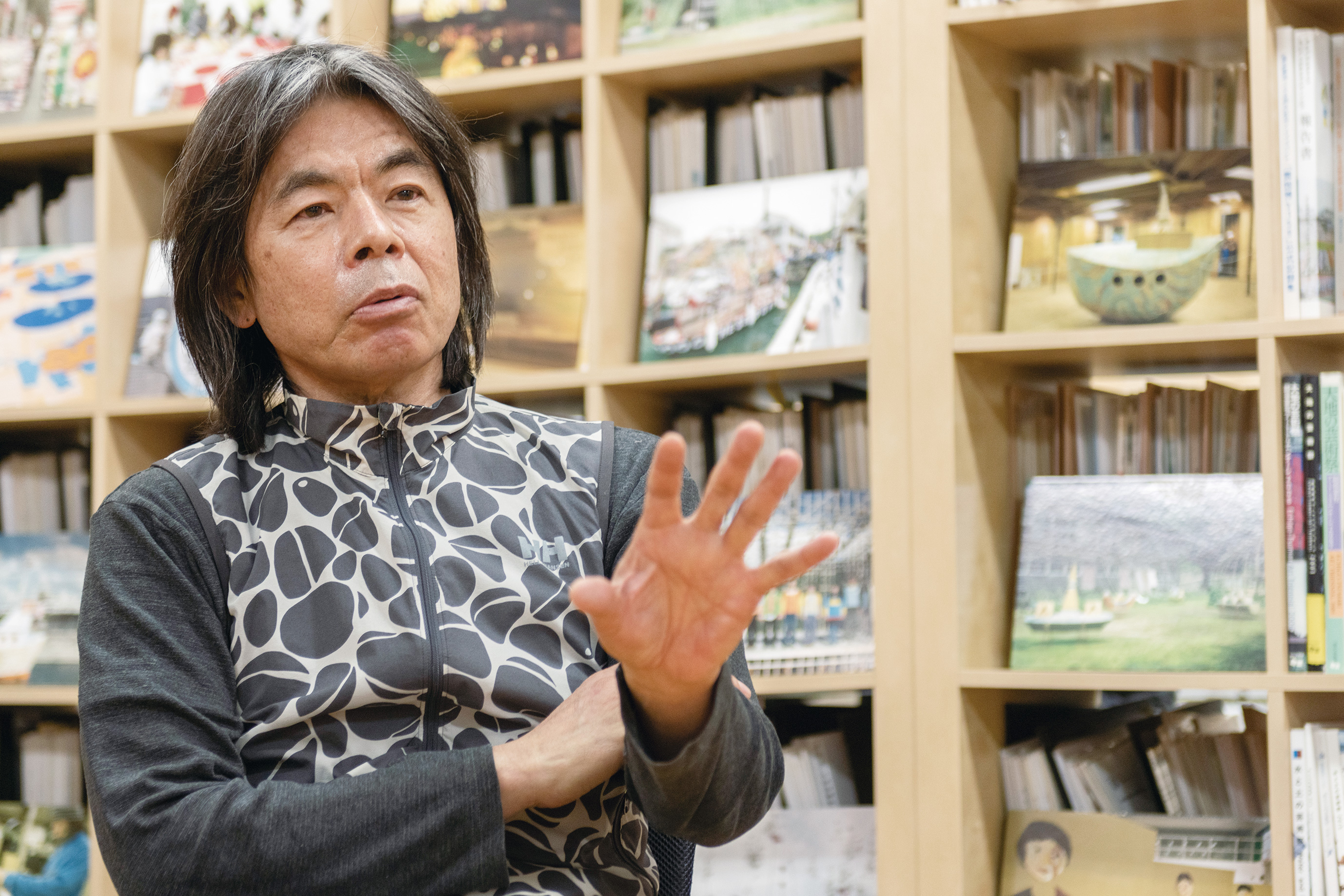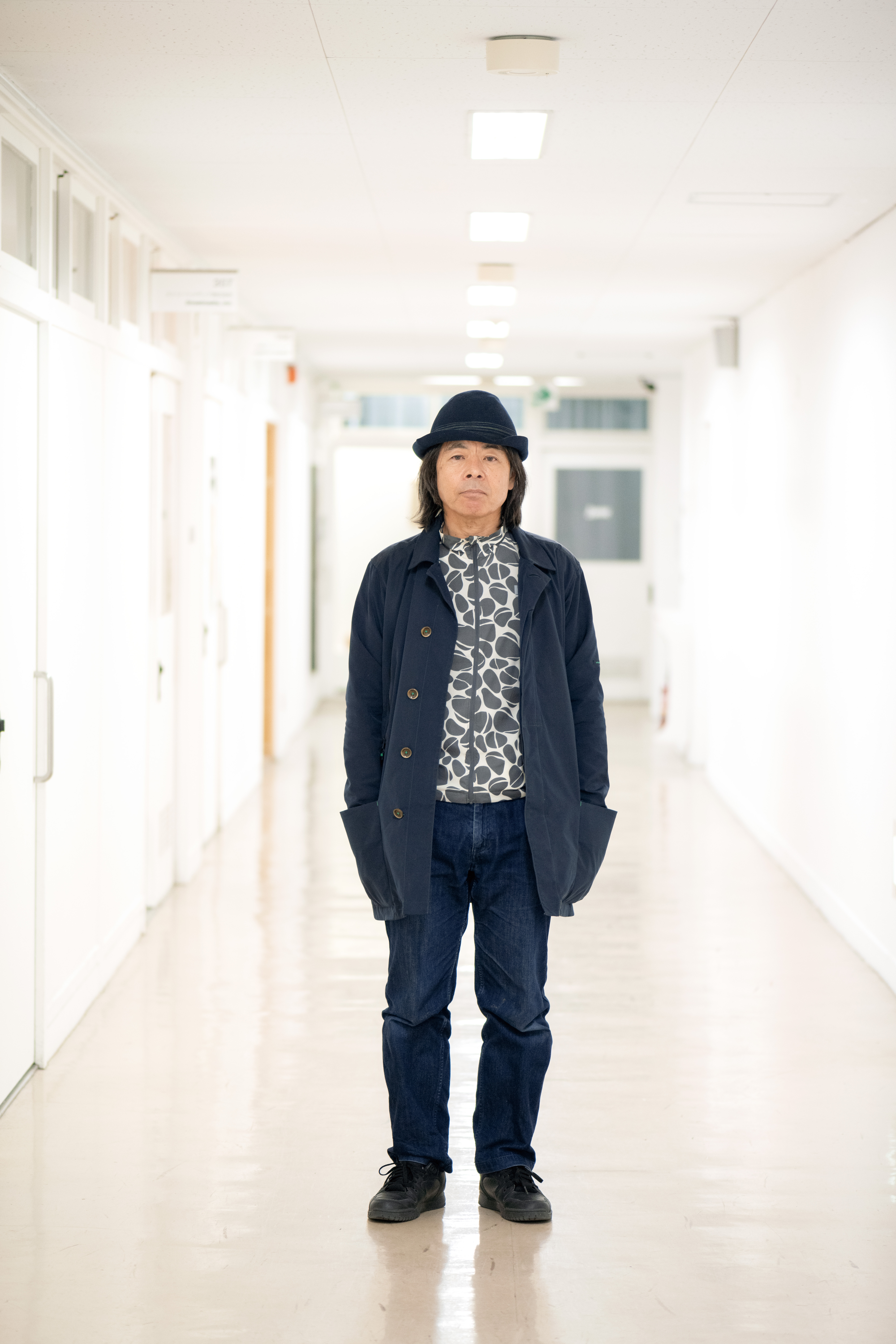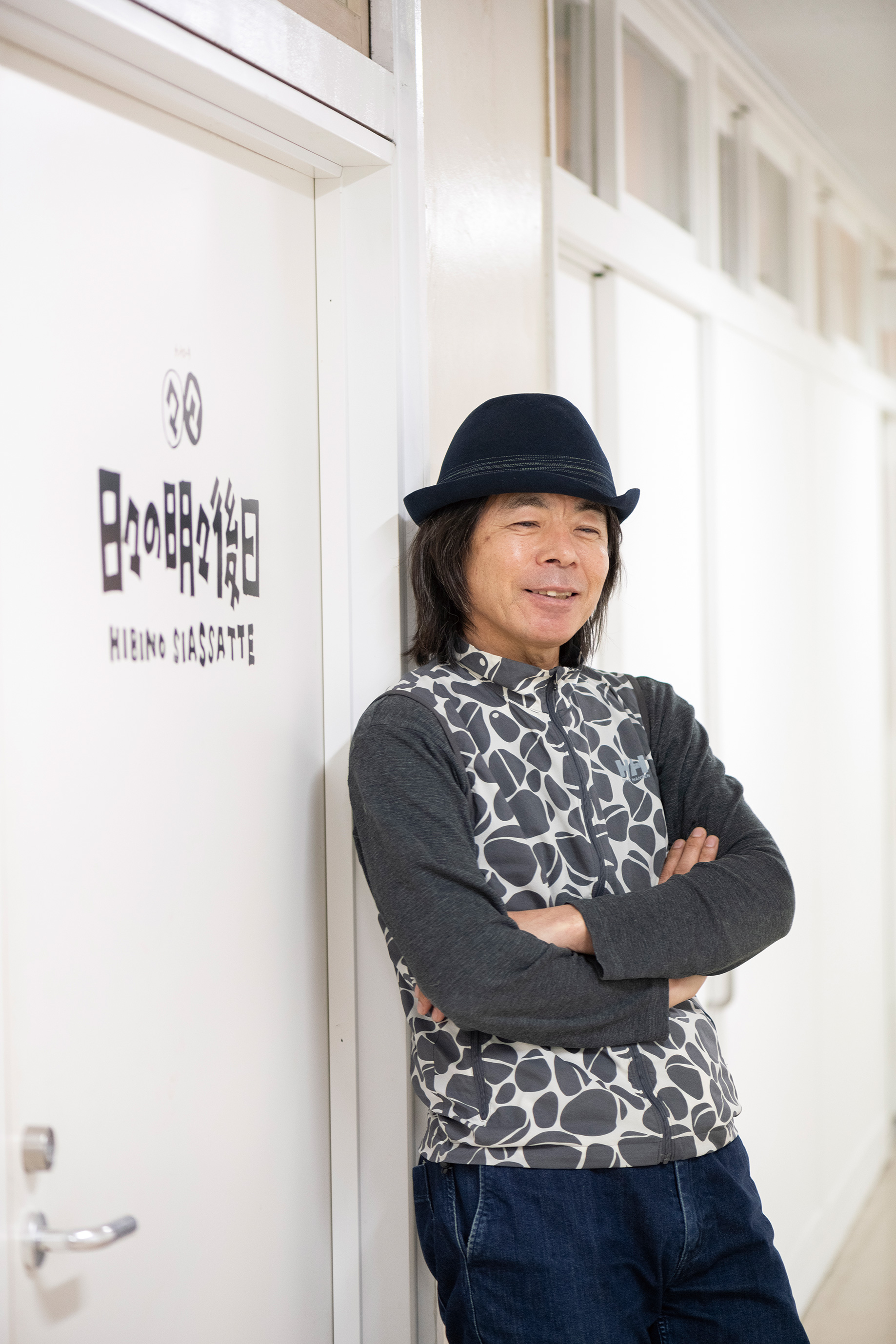
An artist who garnered attention with his cardboard box-based work in the 1980s, Katsuhiko Hibino has maintained activity in a wide range of fields from advertising to stage design. In recent years he has moved beyond personal art production to develop a body of work highlighting
different regions’ unique characters through collaborations with participants from the general public.
Amid the transformation of the world situation as the COVID-19 pandemic and global instability continues with no end in sight, what does this leader at the forefront of the art world in Japan have to say on an artist’s reading of social changes and what he might have in store as his next play. Here, Hibino offers hints for building a brighter future with his words.

KATSUHIKO HIBINO
Born in the city of Gifu in 1958. Earned a degree at the Graduate School of Fine Arts, Tokyo University of the Arts in 1983. Received Grand Prixawards in the 3rd Japan Graphics Exhibition in 1982 and the 3 0th Tokyo Art Directors Club Award in 1983. Exhibited at the Biennale of Sydney in 1986 and the Venice Biennale in 1995. Received the Grand Prix in the Mainichi Design Awards in 1999 and the Agency for Cultural Affairs Development of the Arts Division’s Art Encouragement Prize in 2015. A professor at Tokyo University of the Arts since 2007 and president of the university as of April 1 this year. Other key positions he has held include Director of the Museum of Fine Arts, Gifu, Director of the Contemporary Art Museum, Kumamoto, and chairperson of the Japan Football Association’s Social Contribution Committee.
Website (personal): https://www.hibinospecial.com/
Website (Tokyo University of the Arts): https://www.geidai.ac.jp/
“It is the capacity of art to move people’s hearts and minds,
I believe, that enables it to help solve social issues.”
— You have continually pursued a diverse range of genre-traversing creative activities. What sort of differences exist between your various approaches?
I made a start with my artistic activities in the mid-1980s. Values regarding art underwent a shift around then, and there was a call for new approaches reflective of the times. This mood prevailed for instance when Expo ’70 was held in Osaka, where, amid the urban infrastructure development that was underway, there was a feeling of energy about creating something new. Novel forms of expression were emerging in different artistic fields — with Ryuichi Sakamoto in music, Hideki Noda in theater, and so on.
In art as well, street art — moving out of the museum and taking urban space as a new medium — gained prevalence. In the context of that sort of change in the period, I also expanded my activities, using various media t express my own sensibilities. I might link up with an editor for a magazine, the director of an apparel manufacturer for clothing, or a theatrical director for stage design. In that way, what I took on myself might stay the same, but the storyline of the work would change depending on who I encountered, and how.
— Beyond your personal art production, in recent years you have pursued collaborative art projects with local residents and others, giving the impression that your field of activity is expanding. How has your mindset evolved?
I think one big turning point might have beenthe collapse of the bubble economy in the early 1980s. Around that time, signs of decline began
to appear in the economy, which had always trended upward up until then, accompanied by a string of events that considerably shook my
sense of what is important in life, including the Great Hanshin-Awaji Earthquake (Jan. 1995) and the Tokyo subway sarin attack (Mar. 1995).Times like that really highlight the importance ofties with other people and of interconnection. That made me start to think that art might be just the catalyst that could forge connections
between different people, between people and regional communities, and between different regional communities. As an artist, I can go to a
certain site and engage with local residents there to create collaborative work unique to that place. I have continued to work to convey the fascinating aspects of different regions, social issues, and so on through art projects.
*1.Asatte Asagao Project
(Day After Tomorrow Morning Glory Project)

▲The shuttered Azamihira Elementary School building.
A project that began with having local community members plant morning glories at the closed Azamihira Elementary School in the Azamihira district of Tokamachi, Niigata for the Echigo-Tsumari Art
Triennial 2003. The project has now involved 29 communities from throughout Japan as an activity born of communication between people and local communities.
*2. Tokyo University of the Arts
“Vision for the SDGs”

In February 2022, Tokyo University of the Arts announced its “Vision for the SDGs” outlining the involvement of art in tackling the SDGs with five key points: “Contributing to the Social Change Prescribed by the SDGs,” “Strengthening Social Ties,” “Aiming to be a Sustainable University,” “Fostering Human Resources to Bridge the Divide between Art and
Society,” and “Leveraging Creative Perspectives to Yield Innovation.”
*3. Tokyo University of the Arts
“I LOVE YOU” Project

A project involving the whole university, established to unearth new roles and potentials fitting for art in modern society. The project’s diverse range of undertakings serve to forge connections with all kinds of fields from science and medicine to social welfare, bring new value to light, and convey the power of art to bring more meaning and abundance to society.
HP: https://iloveyou.geidai.ac.jp/

— One of those would be your Asatte Asagao Project (Day After Tomorrow Morning Glory Project*1).
That is a project-based work I started for the Echigo-Tsumari Art Triennial in 2003 that involves planting of morning glory seeds gathered by community residents in Niigata Prefecture. Morning glory seeds collected in Niigata are spread throughout Japan together with the feelings and memories of those community members, where they produce the same scene in a range of different places.
The morning glory seeds serve as a bridge tofacilitate communication between different regional communities and people. This is the 18th year of the project, which has now come to form a vast network connecting 28 regional communities from all over Japan.
―TSUNAGU has introduced a good number of artists who use paper as a material in their work. Paper is just an indispensable material in creative activities, isn’t it?
Commercially sold paper often has slight variations in color and texture, so when I find paper I like, I make a point of stocking up on it.
An artist tends to cling to certain materials once they develop a preference for them. I’ll buy up a good stock just to be safe, since it would be problematic to run out. Then, since in actual practice I end up using every last scrap, my stockpile tends not to get depleted all that quickly after all! (Laughs) Paper can be pretty heavy, so when I moved my studio, it really gave me a workout! (Laughs)
— Is there any certain type of paper that made a lasting impression on you, or that you feel particularly interested in?
I traveled abroad for the first time in my second year at university, and I remember being really impressed by old-looking posters I saw in a city in France at that time. With the limited lifespans we have, people are drawn to materials like gold and marble that never lose their sheen. Paper, though, eventually fades and decays, reflecting the passage of time. I personally feel a strong conviction about finding value in ephemeral beauty. Even more than types of paper offering durability or water resistance, I might tend to be interested in the paper used as packaging for them.

— This continues to be a challenging time for face-to-face communication due to COVID-19.
What kind of effect is that having on the world of art?
What lies ahead is something that can’t be seen right now, and that creates a sense of haziness and uncertainty. That sensation, though, can be a “seedbed” for art. The desire to clear up feelings like that is only human nature, and that struggle for clarity can give rise to artistic expression. The determination to share those feelings of uncertainty, to convey them, to express them, can metamorphosize into the power to create art. The expression of an era always takes shape at the turning point between one period and another. No matter how much digital technologies might evolve and enable high-speed analysis, the basic movements of people’s hearts will still stay the same. I feel like this period might give rise to new forms of
expression unlike anything that came before.
— You just became president of Tokyo University of the Arts this April. How do you think art will involve and contribute to society? What do you see as the social role of art?
There are 17 Sustainable Development Goals established to build a better world, and to achieve them, each of us needs to make changes to our day-to-day behaviors. Think about keeping that up for five, ten years, though. You have to understand that sorting out waste helps reduce the amount of microplastics released into the oceans and thereby leads to marine life conservation. We have to truly want to protect the oceans and the life in them, or we won’t be able to achieve that goal.
In other words, the vital factor is moving people’s hearts and minds. With art, the target is the human heart. Art is the very thing with the capacity to affect people emotionally, to sway them, to effect transformation in their hearts and minds.
example, or giving children with severe disabilities access to art even from their hospital beds. They think of feasible approaches for involving these people in cultural activities and then carry them out, showing acceptance of them as people with unique sets of abilities just the way they are. Ways of thinking in art that take differences between individual people as interesting facets can help us to build an inclusive multicultural society. At Tokyo University of the Arts, we have collections of work made by artists from a wide range of artistic fields as well as archives and can connect up with students and regional industries through a consortium of Japanese art universities. I hope to continue coordinating with companies that have connections to arts and culture in the future and spreading awareness of information beneficial to society. Though the 17 SDGs make no mention of“art” or “culture,” art — which has the capacity to move people’s hearts and minds — is something that runs through each one of them. Art is linked to everysocial issue, and it has the potential to contribute to their resolution.*2 I amdetermined to spread awareness of the appeal and potential inherent to art and fulfilling the role with which I am tasked.
— As we finish up, could you share about your future plans?
At Tokyo University of the Arts, guided by the conviction that “Art loves people,” we have been promoting creative activities under the name of the I LOVE YOU project.*3 This is a project in which artists actively take on social issues and seek to help build an inclusive society, leveraging the power of art. They consider possibilities for offering cultural prescriptions for cognitive impairment, for example, or giving children with severe disabilities access to art even from their hospital beds. They think of feasible approaches for involving these people in cultural activities and then carry them out, showing acceptance of them as people with unique sets of abilities just the way they are.
Ways of thinking in art that take differences between individual people as interesting facets can help us to build an inclusive multicultural society. At Tokyo University of the Arts, we have collections of work made by artists from a wide range of artistic fields as well as archives and can connect up with students and regional industries through a consortium of Japanese art universities. I hope to continue coordinating with companies that have connections to arts and culture in the future and spreading awareness of information beneficial to society.
